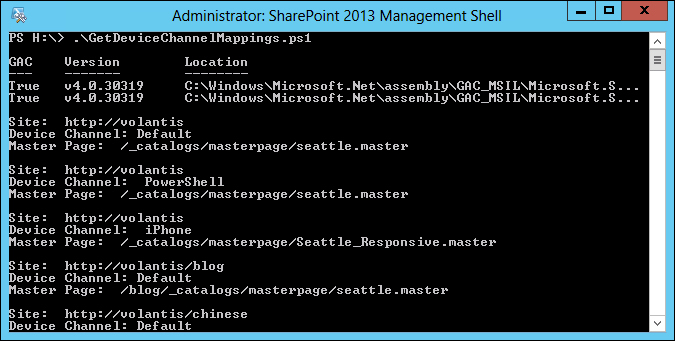Identifying the master pages used by each device channel for each site in a SharePoint farm can be cumbersome. Using PowerShell, the administrators are able to quickly iterate through each site to accomplish this. In this recipe, we are going to use a PowerShell script (PS1) to output the device channels and master pages configured for each site in a site collection.
Follow these steps to list the device channel master page configurations for each site in a site collection with PowerShell:
- Open your preferred text editor to create the PS1 script file.
- Load the
Microsoft.SharePoint.dllandMicrosoft.SharePoint.Publishing.dllassemblies into the PowerShell session.[Reflection.Assembly]::LoadFrom("C:Program FilesCommon Filesmicrosoft sharedWeb Server Extensions15ISAPIMicrosoft.SharePoint.Publishing.dll")[Reflection.Assembly]::LoadFrom("C:Program FilesCommon Filesmicrosoft sharedWeb Server Extensions15ISAPIMicrosoft.SharePoint.dll") - Get the site collection using the
Get-SPSiteCmdlet.$site = Get-SPSite http://sharepoint/sitecollection - Get the object types for the parameters that will be used when getting the class constructor for the
MasterPageMappingsFileobject and later instantiating the object.$typeWeb = [Microsoft.SharePoint.SPWeb] $typeBool = [System.Boolean] $typeMappingFile = [System.Type]::GetType("Microsoft.SharePoint.Publishing.Mobile.MasterPageMappingsFile, Microsoft.SharePoint.Publishing, Version=15.0.0.0, Culture=neutral, PublicKeyToken=71e9bce111e9429c")
- Create an array of the object types.
$consMappingFileParams = ($typeWeb, $typeBool, $typeWeb) - Get the class constructor for the
MasterPageMappingsFileobject.$consMappingFile = $typeMappingFile.GetConstructor($consMappingFileParams) - Create an array of the default parameters required to instantiate the
MasterPageMappingsFileobject.$mappingFileParams = [System.Array]::CreateInstance([System.Object], 3) $mappingFileParams[1] = $false $mappingFileParams[2] = $null
- Use a
foreachloop to iterate through eachSPWebin theAllWebsproperty of theSPSiteobject.foreach ($web in $site.AllWebs) - Add the
SPWebobject to the parameters array and invoke the constructor to create an instance of theMasterPageMappingsFileobject.$mappingFileParams[0] = [Microsoft.SharePoint.SPWeb] $web$mappingFile = $consMappingFile.Invoke($mappingFileParams) - Output the master page settings for the default channel.
Write-Host ""Write-Host "Site: " $web.UrlWrite-Host "Device Channel: Default"Write-Host "Master Page: " $web.CustomMasterUrl - Use a
foreachloop for each device channel key in theKeyscollection of the mapping file.foreach ($key in $mappingFile.Keys) - Output the master page settings for the device channel.
Write-Host "" Write-Host "Site: " $web.Url Write-Host "Device Channel: " $key Write-Host "Master Page: " $mappingFile[$key].MasterPageUrl
- Use the
Disposemethod to discard theSPWebobject.$web.Dispose() - Use the
Disposemethod to discard theSPSiteobject.$site.Dispose() - Save the file as a
PS1file, for example,getdevicechannels.ps1. - Execute the script in the PowerShell session.
./getdevicechannels.ps1
Using .NET reflection we are able to interact with the private methods and classes in the SharePoint assemblies that provide the mapping information of the device channel. In this recipe, we used .NET reflection to instantiate the MasterPageMappingsFile object for each site in the AllWebs property of the site collection we obtained with the Get-SPSite Cmdlet. From the MasterPageMappingsFile object, we were able to output the master page configured for each device channel. In addition, we output the default master page configured for each site.
This recipe may also be accomplished with code using the server-side object model.
Follow these steps to list the device channel master page configurations for each site in a site collection using the server-side object model:
- Get the site collection with a
usingstatement.using (var site = new SPSite("http://sharepoint/sitecollection")) - Get the object type that will be used when getting the class constructor for the
MasterPageMappingsFileobject and later instantiating the object.var typeMappingFile = Type.GetType("Microsoft.SharePoint.Publishing.Mobile.MasterPageMappingsFile, Microsoft.SharePoint.Publishing, Version=15.0.0.0, Culture=neutral, PublicKeyToken=71e9bce111e9429c"); - Get the class constructor for the
MasterPageMappingsFileobject.var consMappingFile = typeMappingFile.GetConstructor(new Type[] {typeof(SPWeb), typeof(bool), typeof(SPWeb)}); - Use a
foreachloop to iterate through each site in theAllWebsproperty of the site collection.foreach (var web in site.AllWebs)
- Ensure that the site exists.
if (web.Exists)
- Invoke the constructor to create an instance of the
MasterPageMappingsFileobject.var mappingFile = consMappingFile.Invoke(new object[] { web, false, null }); - Output the master page settings for the default channel.
Console.WriteLine(""); Console.WriteLine("Site: " + web.Url); Console.WriteLine("Device Channel: Default"); Console.WriteLine("Master Page: " + web.CustomMasterUrl); - Get the
mappingsfield from the mapping file and cast the object as anIDictionary.var mappings = (IDictionary)typeMappingFile.GetField("mappings", BindingFlags.Instance | BindingFlags.NonPublic).GetValue(mappingFile); - Use a
foreachloop for each device channel key in theKeyscollection of the mappings dictionary.foreach (var key in mappings.Keys)
- Get the master page URL from the mappings dictionary.
var mappingObject = mappings[key]; var masterUrl = (string)mappingObject.GetType().GetProperty("MasterPageUrl", BindingFlags.Instance | BindingFlags.Public).GetValue(mappingObject, null); - Output the master page settings for the device channel.
Console.WriteLine(""); Console.WriteLine("Site: " + web.Url); Console.WriteLine("Device Channel: " + key); Console.WriteLine("Master Page: " + masterUrl); - Use the
Disposemethod to discard theSPWebobject.web.Dispose();
- The SharePoint 2013 Design Manager device channels article on MSDN at http://msdn.microsoft.com/en-us/library/jj862343.aspx
- The Reflection in the .NET Framework article on MSDN at http://msdn.microsoft.com/en-us/library/f7ykdhsy.aspx
- The SPWeb class topic on MSDN at http://msdn.microsoft.com/en-us/library/Microsoft.SharePoint.SPWeb.aspx
- The SPSite class topic on MSDN at http://msdn.microsoft.com/en-us/library/microsoft.sharepoint.spsite.aspx
- The Get-SPSite topic on TechNet at http://technet.microsoft.com/en-us/library/ff607950.aspx
